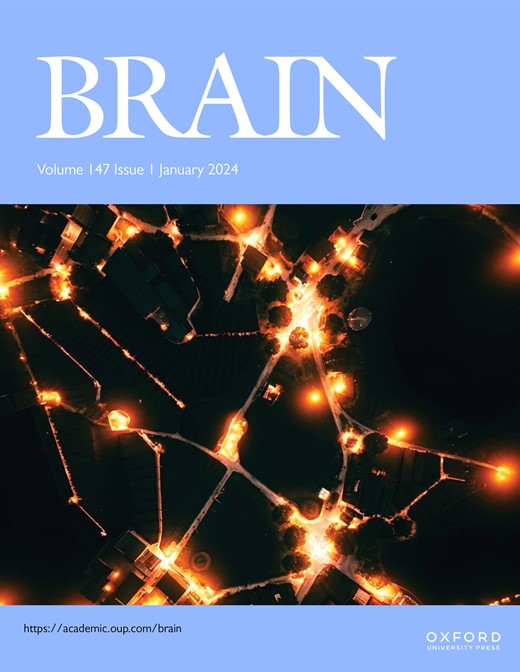Alterations in dopaminergic innervation and receptors in focal cortical dysplasia.
IF 10.6
1区 医学
Q1 CLINICAL NEUROLOGY
引用次数: 0
Abstract
Focal cortical dysplasia (FCD) type 2 is the most common malformation of cortical development associated with pharmaco-resistant focal epilepsy and frequently located in the frontal cortex. Neuropathological hallmarks comprise abnormal cortical layering and enlarged, dysmorphic neuronal elements. Fundamentally altered local neuronal activity has been reported in human FCD type 2 epilepsy surgical biopsies. Of note, FCD type 2 emerges during brain development and forms complex connectivity architectures with surrounding neuronal networks. Local cortical microcircuits, particularly in frontal localization, are extensively modulated by monoaminergic axonal projections originating from the brainstem. Previous analysis of monoaminergic modulatory inputs in human FCD type 2 biopsies suggested altered density and distribution of these monoaminergic axons; however, a systematic investigation is still pending. Here, we perform a comprehensive analysis of dopaminergic (DA) innervation, in human FCD type 2 biopsies and in the medial prefrontal cortex (mPFC) of an FCD type 2 mouse model [mechanistic target of rapamyin (mTOR) hyperactivation model] during adolescent and adult stages. In addition, we analyse the expression of dopamine receptor transcripts via multiplex fluorescent RNA in situ hybridization in human specimens and the mPFC of this mouse model. In the mTOR hyperactivation mouse model, we observe a transient alteration of DA innervation density during adolescence and a trend towards decreased innervation in adulthood. In human FCD type 2 areas, the overall DA innervation density is decreased in adult patients compared with control areas from these patients. Moreover, the DA innervation shows an altered lamination pattern in the FCD type 2 area compared with the control area. Dopamine receptors 1 and 2 appear to be differentially expressed in the dysmorphic neurons in human samples and mTOR-mutant cells in mice compared with normally developed neurons. Intriguingly, our results suggest complex molecular and structural alterations putatively inducing impaired DA neurotransmission in FCD type 2. We hypothesize that this may have important implications for the development of these malformations and the manifestation of seizures.局灶性皮质发育不良中多巴胺能神经支配和受体的改变。
局灶性皮质发育不良(FCD) 2型是与耐药局灶性癫痫相关的最常见的皮质发育畸形,通常位于额叶皮质。神经病理特征包括异常的皮层分层和增大、畸形的神经元元素。据报道,在人类FCD 2型癫痫手术活检中,局部神经元活动发生了根本改变。值得注意的是,FCD 2型在大脑发育过程中出现,并与周围的神经网络形成复杂的连接架构。局部皮层微回路,特别是额叶定位,受到源自脑干的单胺能轴突投射的广泛调节。先前对人类FCD 2型活检中单胺能调节输入的分析表明,这些单胺能轴突的密度和分布发生了改变;然而,系统的调查仍在进行中。在这里,我们在人类FCD 2型活检和FCD 2型小鼠模型(rapamyin (mTOR)过度激活的机制靶点模型)的青春期和成年期对多巴胺能(DA)神经支配进行了全面分析。此外,我们通过多重荧光RNA原位杂交分析了多巴胺受体转录本在人类标本和该小鼠模型的mPFC中的表达。在mTOR过度激活小鼠模型中,我们观察到青春期DA神经支配密度的短暂改变,成年期神经支配密度呈下降趋势。在人类FCD 2型区,与这些患者的对照区相比,成人患者的DA神经支配总体密度降低。此外,与对照区相比,FCD 2型区的DA神经支配表现出改变的层压模式。与正常发育的神经元相比,多巴胺受体1和2在人类样本畸形神经元和小鼠mtor突变细胞中表达差异。有趣的是,我们的研究结果表明,复杂的分子和结构改变可能导致FCD 2型DA神经传递受损。我们假设这可能对这些畸形的发展和癫痫发作的表现有重要的影响。
本文章由计算机程序翻译,如有差异,请以英文原文为准。
求助全文
约1分钟内获得全文
求助全文
来源期刊

Brain
医学-临床神经学
CiteScore
20.30
自引率
4.10%
发文量
458
审稿时长
3-6 weeks
期刊介绍:
Brain, a journal focused on clinical neurology and translational neuroscience, has been publishing landmark papers since 1878. The journal aims to expand its scope by including studies that shed light on disease mechanisms and conducting innovative clinical trials for brain disorders. With a wide range of topics covered, the Editorial Board represents the international readership and diverse coverage of the journal. Accepted articles are promptly posted online, typically within a few weeks of acceptance. As of 2022, Brain holds an impressive impact factor of 14.5, according to the Journal Citation Reports.
 求助内容:
求助内容: 应助结果提醒方式:
应助结果提醒方式:


